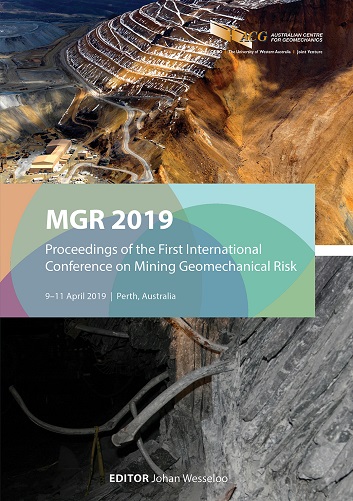Data-driven geotechnical hazard assessment: practice and pitfalls

|
Authors: McGaughey, WJ |
DOI https://doi.org/10.36487/ACG_rep/1905_11_McGaughey
Cite As:
McGaughey, WJ 2019, 'Data-driven geotechnical hazard assessment: practice and pitfalls', in J Wesseloo (ed.), MGR 2019: Proceedings of the First International Conference on Mining Geomechanical Risk, Australian Centre for Geomechanics, Perth, pp. 219-232, https://doi.org/10.36487/ACG_rep/1905_11_McGaughey
Abstract:
Geomechanical risk in mining is universally understood to depend on many apparently disparate factors acting together such as stress, stiffness, mine geometry, rock mass character, rock type, structure, excavation rate and volume, blasting, and seismicity. We have worked on many case studies over the years in both underground and open pit mines with the objective of discovering and documenting the correlation of such factors with the experience of geomechanical failure. Whether that failure is slope failure, strainbursting, fault slip-induced rockbursting, roof fall, or any other of many possible failure types, statistical correlations among the different classes of data can be found, and predictive rules for understanding geohazard based on their quantitative combination can be established and deployed in day-to-day operations. This data-driven approach requires application of methods and avoidance of pitfalls that can be standardised into a universally applicable workflow. We discuss the workflow and the pitfalls in analysis to be avoided through case study examples.
Keywords: geomechanical hazard assessment, data-driven analysis, data fusion, machine learning, artificial intelligence (AI), predictive analytics, rockburst, roof fall, slope failure
References:
Agterberg, FP, Bonham-Carter, GF & Wright, DF 1990, ‘Statistical pattern integration for mineral exploration’, in G Gaal & DF Merriam (eds), Computer Applications in Resource Estimation Prediction and Assessment for Metals and Petroleum, Pergamon Press, Oxford.
Agterberg, FP & Cheng, Q 2002, ‘Conditional independence test for weights-of-evidence modelling’, Natural Resources Research,
vol. 11, no. 4, pp. 249–255.
BearingPoint France SAS 2015, HyperCube, computer software, BearingPoint France SAS, Paris, https://www.hcube.io/en
Bonham-Carter, GF, Agterberg, FP & Wright, DF 1989, ‘Weights of evidence modelling: a new approach to mapping mineral potential’, in FP Agterberg & GF Bonham-Carter (eds), Statistical Applications in the Earth Sciences, Geological Survey of Canada, Ottawa, pp. 171–183.
Castro, L, Cottrell, B, Barker, P & Sintim, K 2011, ‘Application of geohazmap to the pit slope design for the Detour Lake project’, in E Eberhardt & D Stead (eds), Proceedings of the 2011 International Symposium on Rock Slope Stability in Open Pit Mining and Civil Engineering, Canadian Rock Mechanics Association.
Chawla, NV 2010, ‘Data mining for imbalanced datasets: an overview’, in O Maimon & L Rokach (eds), Data Mining and Knowledge Discovery Handbook, Springer, Berlin, pp. 875–886.
Heal, D, Potvin, Y & Hudyma M 2006, ‘Evaluating rockburst damage potential in underground mining’, Proceedings of the 41st US Symposium on Rock Mechanics, American Rock Mechanics Association, Golden.
Larsen, K 2015, Data Exploration with Weight of Evidence and Information Value in R, viewed 1 October 2018, MultiThreaded,
Mira Geoscience Ltd 2017, GOCAD Mining Suite, version 17, computer software, Mira Geoscience Ltd, Montreal, http://www.mirageoscience.com/our-products/software-product/gocad-mining-suite
Morris, A, Ferrill, D & Henderson, D 1996, Slip-tendency Analysis and Fault Reactivation, viewed 1 October 2018,
© Copyright 2025, Australian Centre for Geomechanics (ACG), The University of Western Australia. All rights reserved.
View copyright/legal information
Please direct any queries or error reports to repository-acg@uwa.edu.au
View copyright/legal information
Please direct any queries or error reports to repository-acg@uwa.edu.au
